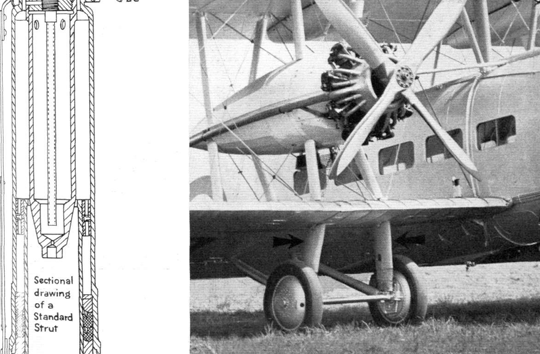Leading the world in
energy absorption
The original Oleo Pneumatics shock absorber was developed from the Vickers gun recuperative gear design which was first applied to an airplane by the French company - Breguet Aviation.
The innovation behind the original design, patented by Vickers Armstrong in 1915, was recoil control by forcing oil through orifices in a positive manner. For many years this principle of energy absorption was developed for the aviation industry for fixed undercarriages and was widely known as an Oleo unit or undercarriage leg. This design was limited by having air above the oil which was not a problem until retracting gears were introduced around 1934.

About this time, Peter Thornhill a founder of Oleo devised a novel design of undercarriage strut using a free floating piston which enabled the whole strut to be inverted, making a lighter arrangement but more importantly enabling the strut to work at an angle eliminating the problem of an oil and air mixture.
"This breakthrough was the seed of invention which eventually led to the Oleo rail buffer."
After many years of research and development for a hydraulic railroad buffer a patent was lodged by Peter Thornhill in 1951, pioneering the first practical design for a self-contained hydraulic buffer for railroad rolling stock. Under the entrepreneurial influence of Oleo's other founder, Jack Onions, a new company was established in 1952 known as Oleo Pneumatics Limited.
Since then Oleo have produced various versions of rail buffers including a design in the early 1960's to meet with the UIC 526 section II specification for high static resistance, this involved a multiplier valve to increase the slow closure gas spring resistance by five times. Over 2000 units were supplied in 1964 to Netherlands Railways and most of these are still in use today.
Oleo's product portfolio has expanded since then to include elevator buffers, industrial buffers, buffer stop solutions and supporting products and services. Testing is done at our factory in Coventry using specialist test rigs developed by Oleo alongside mathematical algorithms that can simulate the linear and non-linear dynamic energy absorption characteristics of our products. This combination of physical testing matched by mathematical analysis enabled Oleo to maintain leading edge products and simulation software.
Research and development is ongoing at Oleo leading to innovation such as deforming element technology, valve design to accommodate a specific client requirement, new elevator buffers and 3D simulation software.
Oleo is now privately owned and has grown from its small beginnings to become a leading world expert in energy absorption technology with manufacturing facilities in Coventry and Shanghai. Products are sold and distributed from our warehouse in Atlanta to support our growing business in the US and Oleo products are sold worldwide through a host of distributors with local servicing by Oleo certified workshops.
Oleo's technological development is based on scrutiny of our own processes and design and manufacturing standards, we are continually modifying the way we work to inspire the next generation of engineers.
Oleo has a complete range of elevator buffers for every application offering a high quality product with minimum life-cycle costs.
Fitting efficient and effective buffer stop solutions will protect passengers, rolling stock and infrastructure in the event of a train failing to stop.
Oleo's industrial energy absorption solutions offer products and services for dockside applications, steelworks, rail infrastructure, and other specialist bespoke applications.
Oleo provides crash energy management products and services to rail operators and train manufacturers. Over 1,000,000 Oleo hydraulic and deformation impact energy absorbers are in daily operation around the world; meeting the requirements for higher levels of protection for passenger and freight rolling stock and operating needs such as higher coupling speeds.